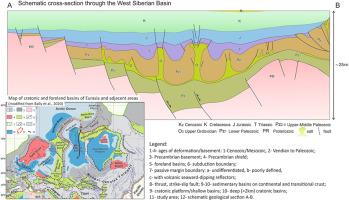Lower Paleozoic salt diapirs in the northern part of the West Siberian Basin and the Enisey-Khatanga Trough: structural setting and petroleum habitat
IF 3.6
2区 地球科学
Q1 GEOSCIENCES, MULTIDISCIPLINARY
引用次数: 0
Abstract
Seismic data from the northern part of the West Siberian Basin and the Enisey-Khatanga Trough indicates the presence of up to 15 km-thick Paleozoic sediments underlying the Mesozoic overburden. This finding challenges the traditional notion that folded Paleozoic rocks constitute the economic basement of the basin. The Paleozoic section comprises evaporitic units, most likely of Ordovician age, which were deposited in troughs formed during the Early Paleozoic Uralian rifting. A reinterpretation of the geological structure suggests that salt tectonics has significantly influenced the subsurface architecture of these regions. Seismic evidence for salt diapirs includes (1) significant heights of salt structures (5 km or more), (2) seismic transparency, (3) minibasin tectonostratigraphic successions flanking the salt structures, and (4) radial fault systems in the overlying deposits. Additional evidence for the occurrence of salt diapirs includes magnetic, gravimetric, thermal, electrical, and topographic anomalies. Minibasin tectonostratigraphic successions suggest that diapirism began soon after salt deposition, preceding the onset of the Late Paleozoic compression. Far-field intracratonic deformations modified salt structures during the Mesozoic-Cenozoic, including extensional episodes in the Early Triassic and Early-Middle Jurassic and contractional episodes in the Late Triassic, Early Cretaceous, and the Late Cenozoic. These events led to folding of post-salt strata, which was accompanied by continuous differential compaction and Quaternary post-glacial rebound of diapirs. These processes amplified anticlines in post-salt Cretaceous reservoirs, which host giant gas accumulations.
The thick and thermally mature Paleozoic deposits include source rocks, which likely significantly contributed to the region's hydrocarbon potential. The upward migration of hydrocarbons through salt structures, from the deeply buried Paleozoic section into the Mesozoic overburden, provides a plausible explanation for the long-debated origin of the abundant gas content in Cretaceous deposits.

西西伯利亚盆地北部和埃尼塞-哈坦加海槽下古生界盐底辟:构造背景与油气栖息地
西西伯利亚盆地北部和Enisey-Khatanga海槽的地震资料表明,在中生代覆盖层下存在高达15公里厚的古生代沉积物。这一发现挑战了褶皱古生代岩石构成盆地经济基础的传统观念。古生代剖面包括蒸发单元,最有可能是奥陶纪,沉积在早古生代乌拉尔裂谷形成的槽中。对地质构造的重新解释表明,盐构造对这些地区的地下构造有重大影响。盐底辟的地震证据包括:(1)显著的盐构造高度(5km或以上),(2)地震透明度,(3)盐构造两侧的小型盆地构造地层序列,(4)上覆矿床的径向断裂系统。盐底辟存在的其他证据包括磁、重、热、电和地形异常。小型盆地构造地层序列表明,底辟作用在盐沉积后不久就开始了,早于晚古生代挤压作用的开始。早三叠世和早中侏罗世的伸展期和晚三叠世、早白垩世和晚新生代的收缩期是远场克拉通内变形改造盐构造的时期。这些事件导致盐后地层褶皱,并伴随着连续的差异压实和第四纪冰后底辟的回弹。这些过程放大了盐后白垩纪储层的背斜,这些储层具有巨大的天然气聚集。厚而热成熟的古生代沉积包括烃源岩,这可能是该区油气潜力的重要贡献。碳氢化合物通过盐构造向上运移,从深埋的古生代剖面进入中生代覆盖层,为白垩纪沉积物中丰富的天然气含量的来源提供了一个长期争论的合理解释。
本文章由计算机程序翻译,如有差异,请以英文原文为准。
求助全文
约1分钟内获得全文
求助全文
来源期刊

Marine and Petroleum Geology
地学-地球科学综合
CiteScore
8.80
自引率
14.30%
发文量
475
审稿时长
63 days
期刊介绍:
Marine and Petroleum Geology is the pre-eminent international forum for the exchange of multidisciplinary concepts, interpretations and techniques for all concerned with marine and petroleum geology in industry, government and academia. Rapid bimonthly publication allows early communications of papers or short communications to the geoscience community.
Marine and Petroleum Geology is essential reading for geologists, geophysicists and explorationists in industry, government and academia working in the following areas: marine geology; basin analysis and evaluation; organic geochemistry; reserve/resource estimation; seismic stratigraphy; thermal models of basic evolution; sedimentary geology; continental margins; geophysical interpretation; structural geology/tectonics; formation evaluation techniques; well logging.
 求助内容:
求助内容: 应助结果提醒方式:
应助结果提醒方式:


